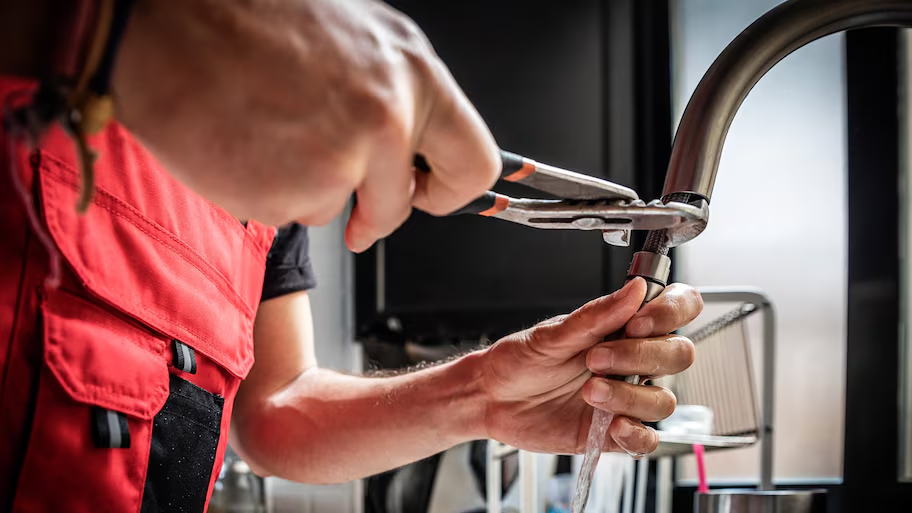What It's Needed to Fix a Broken Faucet
What It's Needed to Fix a Broken Faucet
Blog Article
They are making several great observations on How to Fix a Dripping or Leaky Faucet in general in the content below.

Trickling faucets may appear like a small hassle, yet their impact goes beyond just the inconvenience of the sound. From wasting water to incurring unnecessary financial expenses and health dangers, ignoring a dripping faucet can result in numerous consequences. In this post, we'll explore why it's important to resolve this usual home concern immediately and properly.
Waste of Water
Ecological Effect
Dripping taps contribute considerably to water wastage. According to the Epa (EPA), a single faucet dripping at one drip per secondly can throw away greater than 3,000 gallons of water per year. This not only strains water sources but additionally influences ecological communities and wildlife based on them.
Financial Expenses
Boosted Water Expenses
Beyond the ecological influence, trickling taps can pump up water expenses substantially. The accumulated wastefulness with time equates into higher energy expenditures, which might have been prevented with timely repairs.
Prospective Building Damages
Additionally, prolonged dripping can bring about harm to fixtures and surface areas bordering the faucet. Water buildup can cause discoloration, deterioration, and also structural problems if left neglected, causing added repair service expenses.
Health Issues
Mold And Mildew and Mildew Development
The consistent presence of moisture from a dripping faucet creates an ideal atmosphere for mold and mildew and mildew growth. These fungis not just endanger interior air quality however also present health and wellness risks, particularly for people with breathing problems or allergies.
Waterborne Conditions
Stagnant water in dripping faucets can come to be a breeding ground for bacteria and various other virus, enhancing the danger of waterborne illness. Impurities such as Legionella bacteria flourish in stagnant water, potentially resulting in serious health problems when ingested or breathed in.
DIY vs. Expert Fixing
Pros and Cons of DIY Fixing
While some may try to take care of a dripping tap themselves, do it yourself repair work include their very own collection of difficulties. Without proper understanding and devices, do it yourself attempts can aggravate the problem or lead to incomplete repair work, extending the issue.
Advantages of Employing a Specialist Plumber
Working with a specialist plumber guarantees that the underlying root cause of the trickling tap is resolved successfully. Plumbers have the competence and equipment to identify and fix faucet issues successfully, saving time and decreasing the threat of additional damage.
Step-by-Step Overview to Dealing With a Dripping Faucet
Devices Called for
Prior to trying to repair a dripping faucet, collect the needed devices, consisting of a flexible wrench, screwdrivers, replacement components (such as washing machines or cartridges), and plumber's tape.
Usual Tap Issues and Their Solutions
Identify the type of faucet and the certain problem triggering the drip. Usual problems consist of worn-out washing machines, corroded valve seats, or malfunctioning O-rings. Refer to supplier guidelines or on-line tutorials for step-by-step guidance on repairs.
Safety nets
Regular Maintenance Tips
To prevent trickling faucets, execute regular upkeep such as cleaning aerators, inspecting for leakages, and replacing worn-out parts quickly. In addition, take into consideration setting up water-saving gadgets or upgrading to much more effective fixtures.
Significance of Prompt Fixes
Resolving leaking taps as soon as they're observed prevents further water wastefulness and potential damage, eventually saving both water and money in the future.
Impact on Residential Or Commercial Property Worth
Understanding of Well-Maintained Property
Maintaining a home in good condition, including attending to upkeep concerns like leaking faucets, improves its regarded value and worth among possible buyers or lessees.
Influence on Resale Value
Qualities with well-kept plumbing components, consisting of taps, command greater resale values in the realty market. Attending to leaking faucets can contribute to a favorable impression throughout home inspections and arrangements.
Ecological Duty
Individual Contribution to Preservation
Taking responsibility for repairing trickling taps lines up with broader efforts toward water preservation and ecological sustainability. Every individual's activities jointly make a significant influence on preserving valuable sources.
Lasting Living Practices
By focusing on timely repair services and embracing water-saving behaviors, people contribute to sustainable living methods that profit both existing and future generations.
Conclusion
Resolving a dripping faucet surpasses simple benefit; it's an important action towards preserving water, reducing financial costs, and protecting wellness and building. Whether with do it yourself fixings or specialist assistance, acting to repair dripping faucets is a tiny yet impactful method to promote responsible stewardship of resources and add to a much healthier, much more sustainable future.
How to Fix a Dripping or Leaky Faucet
A leaking faucet is one of the most common problems that homeowners encounter, but it being commonplace doesn’t make it any less annoying. The constant drip drip drip of a leaking bathtub faucet, showerhead, or sink tap can disturb your home’s serenity. Left neglected, a dripping faucet can also result in higher water bills and discoloration or mold growth in your sink or plumbing fixtures.
Fortunately, you don’t have to be a trained plumber to know how to stop a dripping faucet. With some basic tools, replacement parts, and a little patience, leaky faucet repair is a breeze. In this article, we’ll explain what causes dripping faucets and how you can fix them.
What Causes a Leaking Faucet?
Kitchen and bathroom faucets come in all manner of designs, but most involve some combination of valves, O-rings, seals, and washers. The O-ring is usually the weakest link, but any one of these pieces can wear down over time. Heat, moisture, temperature fluctuations, minerals, mold, and movement can contribute to warping and corrosion, breaking the watertight seal. This just comes with the territory of being a homeowner. Everything is always subject to wear and tear, and some component parts of your appliances and fixtures need to be replaced on occasion. At least replacement O-rings are cheap!
More rarely, dripping faucets can be a symptom of excessively high water pressure. Were this the case in your home, you would probably notice that the leak is not isolated to one faucet. Water pressure issues are harder to resolve on your own. We recommend contacting a professional plumber if you suspect your water pressure is too high.
How to Fix a Dripping Faucet
Pipe wrench or monkey wrench Allen wrench set Screwdrivers Old towel or rag Shut off the water.
Before you do anything, you need to turn off the water to keep from drenching your kitchen or bathroom. You should find a valve under the sink and against the wall. Once you’ve turned this valve, try turning the faucet on to confirm that the water source has been cut off.
If you can’t locate your local valve for the faucet you’re working on, you can always shut off the water to the house at the main valve. Of course, this will prohibit anyone from using the sinks, showers, or toilets while you’re working on the faucet that’s giving you trouble.
Plug or block the drain.
You’ll be disassembling the faucet and removing some small bits of hardware. Plug the drain with a stopper or rag to avoid the possibility of a small screw falling into your P-trap.
Take apart the faucet assembly.
There are several varieties of kitchen and bathroom faucets, each with its own manner of assembly. For detailed instructions on how to disassemble your faucet, you can refer to the fixture’s manual or contact the manufacturer. If you know whether you have a ball, disc, cartridge, or compression faucet, you can find detailed schematics online.
In general, you need to begin by removing the faucet handles. You might notice a small screw that you’ll need to remove with a screwdriver or Allen wrench. If you don’t see any visible securing hardware, it’s likely hidden under a decorative cap that can be unscrewed or popped off with flathead screwdriver.
Remove each piece methodically, consulting a schematic when necessary. Take notes or arrange the pieces in such a way to make it easier to correctly reassemble the faucet later.
Remove the cartridge.
Once you’ve removed the handles and securing hardware, you should be able to remove the valve cartridge or stem. Some cartridges will slide right out. Other faucet models will require you to loosen a nut with a pipe wrench before you can remove the valve stem.
Examine the exposed hardware.
With the cartridge or stem removed, inspect the component parts. Check the rubber O-rings for wear and tear. Also examine the seat washer for corrosion or other damage. These pieces are usually the responsible parties for a dripping faucet, but it’s worth inspecting the other component parts while you have the faucet disassembled.
Find replacement parts.
Once you’ve identified which faucet component has failed, find an identical replacement. Your local hardware store should have O-rings, seat washers, and other standard components in stock. If you have a luxury or uncommon faucet, you may have to contact the manufacturer for a replacement part.
It’s a good idea to take your old parts with you to the hardware store so you can compare them with the store’s inventory and be sure you’re purchasing the correct replacement.
Reassemble the faucet.
With your new parts in hand, reconstruct the faucet and handles. Don’t be tempted to overtighten screws or nuts. You might think this could create a better seal, but it can instead damage or bend a delicate part of the assembly and create a new problem for you.
Turn on the water and test the faucet.
The only thing left to do is test your work. Unplug the sink, turn the water back on, and try the faucet. Congratulate yourself on a job well done!
https://www.libertyhomeguard.com/how-to-fix-a-dripping-or-leaky-faucet/

Hopefully you liked our section on . Thanks for taking a few minutes to read our blog post. Don't hesitate to pause to share this blog entry if you enjoyed reading it. Thank you so much for going through it.
Report this page